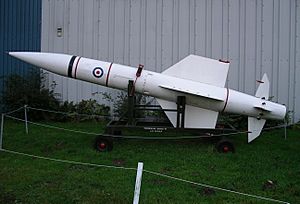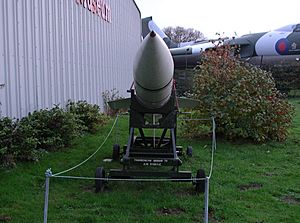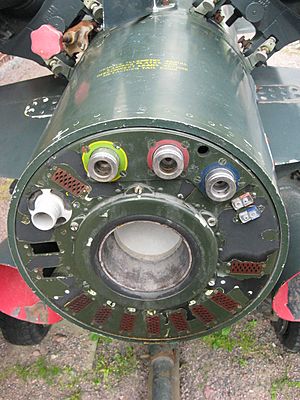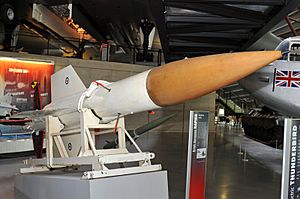Thunderbird (missile) facts for kids
Quick facts for kids Thunderbird |
|
|---|---|

Thunderbird II at Imperial War Museum Duxford
|
|
| Type | Surface-to-air missile |
| Place of origin | United Kingdom |
| Service history | |
| In service | 1959-1977 |
| Used by | British Army Royal Saudi Air Force |
| Production history | |
| Manufacturer | English Electric |
| Specifications | |
| Length | 20 ft 10 in (6.35 m) |
| Diameter | 1 ft 8.7 in (0.527 m) |
| Warhead | Continuous-rod HE warhead |
|
|
|
| Engine | liquid fuel rocket 4 x Gosling solid fuel rocket |
| Wingspan | 5 ft 4 in (1.63 m) |
| Maximum speed | Mach 2.7 |
|
Guidance
system |
semi-active radar homing |
|
Launch
platform |
Single rail, ground mounted (not mobile) |
The English Electric Thunderbird was a powerful surface-to-air missile made in Britain. It was designed for the British Army. Its main job was to shoot down enemy aircraft flying at high altitudes. It could hit targets up to about 30 miles (48 km) away.
The Thunderbird helped protect the Army in the field from air attacks. Older anti-aircraft guns were still used for planes flying lower. The Thunderbird started being used in 1959. It got a big upgrade in 1966, becoming the Thunderbird 2. It was slowly replaced by 1977. Some older Thunderbirds were also used by the Royal Saudi Air Force after 1967.
The Thunderbird was similar to other missiles like the US MIM-23 Hawk. After its upgrades, it used a special radar system. This system was very good at avoiding radar jamming and deception. It could even track targets flying very low to the ground. The Thunderbird was the Army's only heavy anti-aircraft missile. Later, the smaller Rapier missile took over its role.
Contents
How the Thunderbird Missile Was Developed

The story of the Thunderbird missile began in 1947. At that time, many different missile ideas were being studied. These ideas came from the British Army, Navy, and Air Force. All these projects were then managed by the Ministry of Supply.
The Navy wanted a missile to stop planes carrying glide bombs. These bombs could be launched from far away. A group called the GAP Committee was formed to look at these designs. They wanted a missile that could hit planes before they got too close.
The Navy's missile idea changed as planes got faster. It was named Seaslug in 1947. The Army and Air Force also needed missiles. They wanted ones that could fly faster and farther. This new project was given the code name "Red Heathen." The company English Electric won the contract to develop it.
Designing the Missile

English Electric's design for the Thunderbird was quite simple. It had a long, round body with a pointed nose. There were four wings in the middle and four smaller control fins at the back.
The missile was powered by a liquid fuel rocket engine. It also had four large "Gosling" solid fuel rocket boosters. These boosters helped launch the missile into the air. They had special fins that helped them fall away cleanly after launch.
The missile used semi-active radar homing to find its target. This means it would guide itself towards radar signals bouncing off the enemy plane. The "Yellow River" radar system helped find and light up the targets.
Early tests showed that the Army did not want a liquid fuel rocket. It was too hard to handle the fuel in the field. So, a solid rocket engine was chosen instead. The Thunderbird missile officially entered service in 1959. It was the first British-designed missile used by the British Army.
Upgrades and Improvements
As technology improved, new radars were developed. These new radars made existing missiles much better. For the Thunderbird, a new radar called "Indigo Corkscrew" was used. This radar greatly improved how well the missile could hit low-flying targets. It also worked much better against electronic countermeasures.
To help the Thunderbird operate, new surveillance radars were added. These radars could find targets from a longer distance. They were known as "Big Ears" and "Noddy."
The missile itself also got some changes. The new version, called Thunderbird 2, had bigger boosters. Its wings were also larger and shaped differently. The nose cone was also redesigned. Even with these changes, the Thunderbird 2 still looked a lot like the first version.
The improved Thunderbird 2 missiles started service in 1966. They were used until 1977.
Who Used the Thunderbird?
The Thunderbird missile was mainly used by the British Army. After 1967, some older Thunderbird missiles were also used by the Royal Saudi Air Force.
Possible Users
There were also talks with Libya and Zambia about them using the Thunderbird.
Where to See a Thunderbird Today
The Thunderbird is a popular item in museums across the UK.
- One missile is on display at the Midland Air Museum in Warwickshire, England.
- Another is at Firepower - The Royal Artillery Museum in Woolwich, England.
- A Thunderbird Mk1 can be seen at the National Museum of Flight in Scotland.
- There's also one outside the Combined Services Military Museum in Maldon, Essex.
- A Thunderbird nose cone is at the Predannack Anti-Aircraft Battery and museum in Cornwall, UK.
Two Finnish missiles are still around. One is in Museo Militaria, Hämeenlinna. Another is in the Anti-aircraft Museum, Tuusula. You can also see a Thunderbird in Woomera, Australia, at the Woomera Rocket Range.
Thunderbird Facts
- Length: 6.35 meters (20 feet 10 inches)
- Body Diameter: 0.527 meters (1 foot 8.7 inches)
- Fin Span: 1.63 meters (5 feet 4 inches)
- Warhead: Continuous HE rod (a type of explosive that expands in a ring)
- Speed: Mach 2.7 (about 2.7 times the speed of sound)
- Range: 75 kilometers (47 miles)
See also
- Bristol Bloodhound - a similar weapon used by the RAF
- Hawker Siddeley Seaslug - a similar weapon used by the Royal Navy
- List of Rainbow Codes




